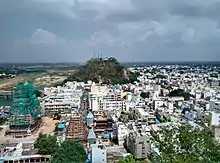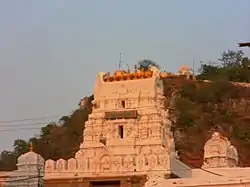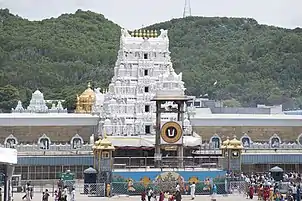Srikalahasteeswara temple
The Srikalahasti Temple is located in the town of Srikalahasti, in Tirupati district in the state of Andhra Pradesh, India. According to regional tradition, it is said to be the site where Kannappa was ready to offer both his eyes to cover blood flowing from the linga before Shiva stopped him and granted him moksha.[3]
| Sri Gnanaprasunambika sametha Srikalahasteeswara Temple శ్రీ జ్ఞాన ప్రసూనాంబికా సమేత శ్రీ కాళ హస్తిశ్వర ఆలయం | |
|---|---|
 An aerial view of the town and the temple | |
| Religion | |
| Affiliation | Hinduism |
| District | Tirupati |
| Deity | Srikalahasteeswara (Shiva), Gnana Prasunambika Devi[1] (Parvati) |
| Festivals | Maha Sivaratri |
| Location | |
| Location | Srikalahasti |
| State | Andhra Pradesh |
| Country | India |
.svg.png.webp) Location in Andhra Pradesh | |
| Geographic coordinates | 13°44′58″N 79°41′54″E |
| Architecture | |
| Type | Dravidian architecture[2] |
| Creator | Rajendra Chola I |
| Website | |
| Srikalahasti | |
Srikalahasti temple, situated 36 km away from Tirupati and 40 km away from the district headquarters Nellore, is famous for its Vayu Lingam (Wind Lingam), one of the Pancha Bhuta Sthalams, representing the wind. The temple is also regarded as Rahu-Ketu kshetra and Dakshina Kailasam. The inner temple was constructed around the 5th century and the outer temple was constructed in the 11th century by the Rajendra Chola I, later Chola kings and the Vijayanagara kings. Shiva in his aspect as Vayu is worshipped as Kalahasteeswara.
Legend
In primordial times, the wind-god Vayu performed penance for thousands of years to the Karpoora lingam, the lingam of Shiva made of camphor. Pleased with Vayu's penance, Shiva manifested before him and bestowed him three boons. Vayu was blessed to present everywhere in the world in form of air and want to be an integral part of every being in form of vayus. Further, The linga Vayu worshipped was named as Vayu lingam after him and was declared to be worshipped by various beings.[4]
Another legend narrates that Shiva's consort Parvati who was cursed by him to discard her divine form and assume human form. To atone, Parvati performed penance at Srikalahasti and pleased Shiva. Shiva granted her a heavenly body, a hundred times better than her previous divine form. Parvati is worshipped as Shiva-Gnanam Gnana Prasunamba or Gnana Prasunambika Devi in the temple.
Cursed to become a ghost, Ghanakala prayed at Srikalahasti for 15 years and after chanting the Bhairava Mantra, Shiva restored her original form.
Mayura, Chandra and Devendra were also freed from their curses after taking bath in the river Swarnamukhi and praying at Srikalahasti.
Shiva appeared before the sage Markandeya in Srikalahasti and preached that a Guru alone could make esoteric teachings and, therefore he is Brahma, Vishnu and Maheswara.
As per another legend, Vayu and Shesha had a dispute to find out who is superior, to prove the superiority Shesha encircled Mount Kailash, the abode of Shiva, Vayu tried to remove this encircle by creating a twister. Because of the twister, 8 parts of the mountain fell into 8 different places which are Trincomalee, Srikalahasti, Thiruchiramalai, Thiruenkoimalai, Rajathagiri, Neerthagiri, Ratnagiri, and Suwethagiri Thirupangeeli.[5]
History

Around the 11th century, the Chola king Rajendra Chola I king renovated the temple and constructed the main structure.[6] The temple received contributions from various ruling dynasties like Chola Dynasty and Vijayanagar Empire. The 120 feet (37 m) high main gopuram and the hundred pillared hall with intricate carvings was commissioned during the regime of the Vijayanagara Krishnadevaraya during 1516 AD.[7]
The main gopuram built by the king Krishnadevaraya, collapsed on 26 May 2010.[8][9] As per the Archaeology Department, the temple tower stood on a foundation that had a depth of only one-and-a-half feet and had a thin crack 25 years before it collapsed which expanded as years passed by.[10][11] The Rajagopuram was reconstructed in its original form at the same location with a budget of 45 crores and was consecrated on 18 January 2017.[8]
Architecture

The presiding image of Shiva in the form of Linga is made of white stone in a shape resembling trunk of elephant. The temple faces south, while the sanctum faces west. The temple is located on the foothills of a hill, while there is also a belief that the temple was carved out of a monolithic hill. There is a rock cut shrine of Vinayaka, 9 ft (2.7 m) below the ground level. Vallaba Ganapathi, Mahalakshmi-Ganpathi and Sahasra Lingeswara are some of the rare images found in the temple. There is a large shrine of Jnanaprasanammba, the consort of Kalahatisvara. There are smaller shrines in the temple for Kasi Viswanatha, Annapurna, Suryanarayana, Sadyoganapathi and Subramanya. There are two large halls namely Sadyogi Mandapa and Jalkoti Mandapa. There are two water bodies associated with the namely, Surya Pushkarani and Chandra Pushkarani.[7]
Religious importance

The temple is revered as one of the Pancha Bhoota Stalam where the presiding deity is worshipped as Vayu linga (air). This temple is considered "Kashi of the South".[12] Saivaite saints of the first century sang about this temple. This is the only temple in India which remains open during Solar and lunar eclipses, while, all other temples are closed.[13] This temple is famous for Rahu-Kethu pooja. It is believed that performing this pooja will ward the people from astrological effects of Rahu and Kethu.[13] As per Hindu legend, Kalahasteeshwara was worshipped at this place by Brahma during all four Yugas. Arjuna, the Pandava prince during Mahabharata is believed to have worshipped the presiding deity. The legend of Kannappa, who was a hunter and turned into an ardent devotee of Shiva accidentally, is associated with the temple. The temple also finds mention in the works of Nakeerar and the Nalvars, namely, Appar, Sundarar, Sambandar and Manickavasagar in the canonical works of Tirumura.[7] As the temple is revered in Tevaram, it is classified as Paadal Petra Sthalam, one of the 275 temples that find mention in the Saiva canon.[14]
Culture
The temple follows Saivite tradition. Maha Shivaratri is the most important festival when lakhs of devotees offer prayers to seek the blessings of the Lord. Mahasivaratri Brahmotsavams are celebrated in par with Maha Shivaratri for 13 days during which the Utsava murtis of Siva and Parvati will be taken on Vahanams in a procession around the temple streets.[15]
The presiding deity of the temple Gnana Prasunambika Devi was born in Vellathurar Gotra of Senguntha Kaikolar. Customary for the bride to bring home the dowry and submit it by these Vellathurar peoples at the Shiva-Parvati wedding held here.[16][17]
References
- "Srikalahasti Temple History".
- Aguilar, Rafael; Torrealva, Daniel; Moreira, Susana; Pando, Miguel A.; Ramos, Luis F. (2018). Structural Analysis of Historical Constructions: An Interdisciplinary Approach. Springer. ISBN 9783319994413. Retrieved 26 February 2019.
- Devadiga, Disha (31 January 2022). "Srikalahasteeswara temple – The Kashi of South". Temples of India Blog. Retrieved 20 May 2022.
- "Official Wesbsite of Srikalahasti Temple". Retrieved 1 March 2017.
- "Arulmigu Gneelivaneswarar Temple". Archived from the original on 5 July 2018. Retrieved 6 July 2018.
- Subramaniam, T. s. (4 June 2010). "History begin". The Hindu. Retrieved 1 March 2017.
- Harshananda, Swami (2012). Hindu Pilgrim centres (2nd ed.). Bangalore, India: Ramakrishna Math. pp. 53–7. ISBN 978-81-7907-053-6.
- "Rajagopuram at Srikalahasti Temple to be opened on January 18". Retrieved 14 March 2017.
- "Srikalahasti temple tower crashes". The Hindu. 27 May 2010. Retrieved 14 March 2017.
- P Neelima (27 September 2010). "Srikalahasti 'rajagopuram' an architectural wonder," The Times of India
- Subramaniam, T. s. (4 June 2010). "Blow to History". The Hindu. Retrieved 1 March 2017.
- "Sivaratri Brahmotsavams begin". Srikalahasteeswar Temple administration. Retrieved 1 March 2017.
- "Temples, barring Srikalahasti, closed for lunar eclipse". The Hindu. 5 April 2015. Retrieved 1 March 2017.
- Sundarar. "Seventh Thirumurai". Thevaram.org. Retrieved 30 November 2015.
- "Srikalahasti gears up for Mahasivaratri Brahmotsavam". Retrieved 1 March 2017.
- "வெள்ளாத்தூர் அம்மன் கோவில் பால்குட விழா - Dinamalar Tamil News".
- "கடந்த ஆடியில் கேட்டது; நடப்பு ஆடியில் நடக்குது; வெள்ளாத்தூர் அம்மன் கோவில் தூர் வாரும் பணி - Dinamalar Tamil News".




